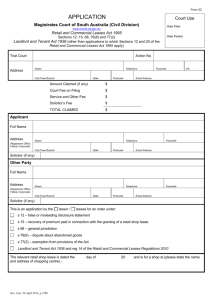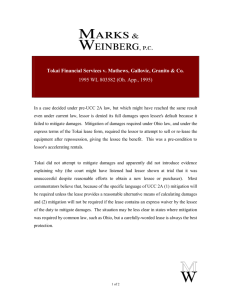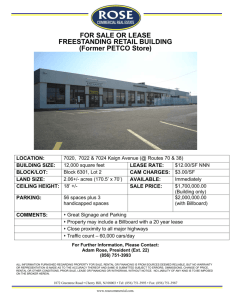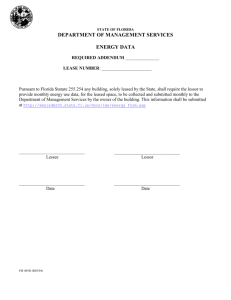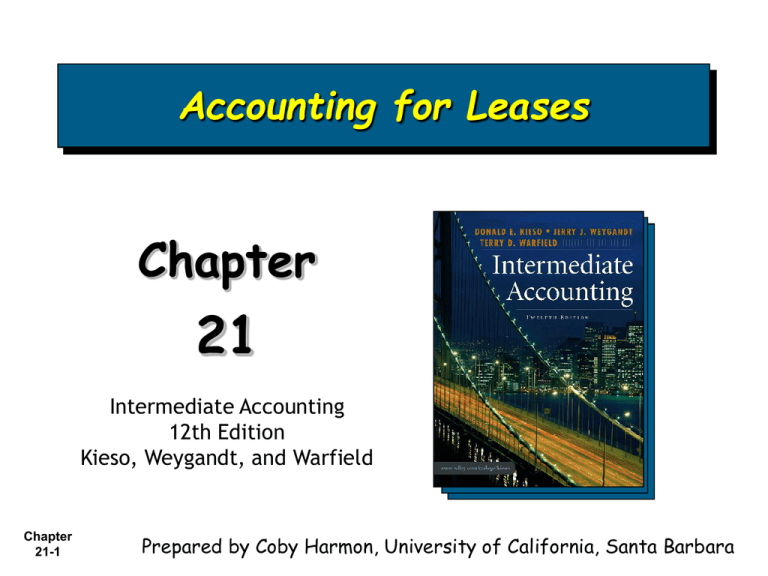
Accounting for Leases
Chapter
21
Intermediate Accounting
12th Edition
Kieso, Weygandt, and Warfield
Chapter
21-1
Prepared by Coby Harmon, University of California, Santa Barbara
Learning Objectives
1.
Explain the nature, economic substance, and advantages of lease
transactions.
2.
Describe the accounting criteria and procedures for capitalizing
leases by the lessee.
3.
Contrast the operating and capitalization methods of recording
leases.
4.
Identify the classifications of leases for the lessor.
5.
Describe the lessor’s accounting for direct-financing leases.
6.
Identify special features of lease arrangements that cause
unique accounting problems.
7.
Describe the effect of residual values, guaranteed and
unguaranteed, on lease accounting.
8.
Describe the lessor’s accounting for sales-type leases.
9.
List the disclosure requirements for leases.
Chapter
21-2
Accounting for Leases
Leasing
Environment
Accounting
Lessee
by
Accounting
Lessor
by
Special
Accounting
Problems
Who are
players?
Capitalization
criteria
Economics of
leasing
Advantages of
leasing
Accounting
differences
Classification
Sales-type
leases
Conceptual
nature of a lease
Capital lease
method
Direct-financing
method
Bargain
purchase option
Operating
method
Initial direct costs
Operating
method
Comparison
Residual values
Current versus
noncurrent
Disclosure
Unsolved
problems
Chapter
21-3
The Leasing Environment
A lease is a contractual agreement between a lessor
and a lessee, that gives the lessee the right to use
specific property, owned by the lessor, for a
specified period of time.
Largest group of leased equipment involves:
Information technology,
Transportation (trucks, aircraft, rail),
Construction and
Agriculture.
Chapter
21-4
LO 1 Explain the nature, economic substance,
and advantages of lease transactions.
The Leasing Environment
Who Are the Players?
Three general categories:
Banks.
Captive leasing companies.
Independents.
Chapter
21-5
LO 1 Explain the nature, economic substance,
and advantages of lease transactions.
The Leasing Environment
Advantages of Leasing
1.
100% Financing at Fixed Rates.
2. Protection Against Obsolescence.
3. Flexibility.
4. Less Costly Financing.
5. Tax Advantages.
6. Off-Balance-Sheet Financing.
Chapter
21-6
LO 1 Explain the nature, economic substance,
and advantages of lease transactions.
The Leasing Environment
Conceptual Nature of a Lease
Capitalize a lease that transfers substantially all
of the benefits and risks of property ownership,
provided the lease is noncancelable.
Leases that do not transfer substantially all the
benefits and risks of ownership are operating
leases.
Chapter
21-7
LO 1 Explain the nature, economic substance,
and advantages of lease transactions.
The Leasing Environment
The issue of how to report leases is the case of substance versus
form. Although technically legal title may not pass, the benefits
from the use of the property do.
Operating Lease
Journal Entry:
Rent expense
Cash
xxx
xxx
Capital Lease
Journal Entry:
Leased equipment
Lease obligation
xxx
xxx
A lease that transfers substantially all of the benefits and risks of
property ownership should be capitalized (only noncancellable leases
may be capitalized).
Statement of Financial Accounting Standard No. 13,
“Accounting for Leases,” 1980
Chapter
21-8
LO 1 Explain the nature, economic substance,
and advantages of lease transactions.
Accounting by the Lessee
If the lessee capitalizes a lease, the lessee records
an asset and a liability generally equal to the present
value of the rental payments.
Records depreciation on the leased asset.
Treats the lease payments as consisting of
interest and principal.
Chapter
21-9
LO 2 Describe the accounting criteria and procedures
for capitalizing leases by the lessee.
Accounting by the Lessee
To record a lease as a capital lease, the lease must
be noncancelable.
One or more of four criteria must be met:
1. Transfers ownership to the lessee.
2. Contains a bargain purchase option.
3. Lease term is equal to or greater than 75 percent of
the estimated economic life of the leased property.
4. The present value of the minimum lease payments
(excluding executory costs) equals or exceeds 90
percent of the fair value of the leased property.
Chapter
21-10
LO 2 Describe the accounting criteria and procedures
for capitalizing leases by the lessee.
Accounting by the Lessee
Leases that DO NOT
meet any of the four
criteria are accounted for
as Operating Leases.
Lease Agreement
No
Transfer
of
Ownership
Yes
No
Bargain
Purchase
No
Lease Term
>= 75%
Yes
Yes
Capital Lease
Chapter
21-11
PV of
Payments
>= 90%
Yes
No
O
p
e
r
a
t
i
n
g
L
e
a
s
e
LO 2 Describe the accounting criteria and procedures
for capitalizing leases by the lessee.
Accounting by the Lessee
Recovery of Investment Test (90% Test)
Discount Rate
Lessee computes the present value of the
minimum lease payments using its incremental
borrowing rate, with one exception.
If the lessee knows the implicit interest
rate computed by the lessor and it is less
than the lessee’s incremental borrowing rate,
then lessee must use the lessor’s rate.
Chapter
21-12
LO 2 Describe the accounting criteria and procedures
for capitalizing leases by the lessee.
Accounting by the Lessee
Recovery of Investment Test (90% Test)
Minimum lease payments:
Minimum rental payment
Guaranteed residual value
Penalty for failure to renew
Bargain purchase option
Executory Costs:
Chapter
21-13
Insurance
Maintenance
Taxes
Exclude from PV of
Minimum Lease
Payment calculation
LO 2 Describe the accounting criteria and procedures
for capitalizing leases by the lessee.
Accounting by the Lessee
Asset and Liability Accounted for Differently
Asset and Liability Recorded at the lower of:
1. the present value of the minimum lease
payments (excluding executory costs) or
2. the fair-market value of the leased asset.
Chapter
21-14
LO 2 Describe the accounting criteria and procedures
for capitalizing leases by the lessee.
Accounting by the Lessee
Asset and Liability Accounted for Differently
Depreciation Period
If lease transfers ownership, depreciate asset
over the economic life of the asset.
If lease does not transfer ownership,
depreciate over the term of the lease.
Chapter
21-15
LO 2 Describe the accounting criteria and procedures
for capitalizing leases by the lessee.
Accounting by the Lessee
E21-1 (Capital Lease with Unguaranteed Residual Value) On
January 1, 2007, Burke Corporation signed a 5-year noncancelable
lease for a machine. The terms of the lease called for Burke to
make annual payments of $8,668 at the beginning of each year,
starting January 1, 2007. The machine has an estimated useful life
of 6 years and a $5,000 unguaranteed residual value. Burke uses
the straight-line method of depreciation for all of its plant assets.
Burke’s incremental borrowing rate is 10%, and the Lessor’s
implicit rate is unknown.
Instructions
(a) What type of lease is this? Explain.
(b) Compute the present value of the minimum lease payments.
(c) Prepare all journal entries for Burke through Jan. 1, 2008.
Chapter
21-16
LO 2 Describe the accounting criteria and procedures
for capitalizing leases by the lessee.
Accounting by the Lessee
E21-1 What type of lease is this? Explain.
Capitalization Criteria:
Capital Lease, #3
1. Transfer of ownership
NO
NO
2. Bargain purchase option
3. Lease term => 75% of
economic life of leased
property
4. Present value of minimum
lease payments => 90% of
FMV of property
Chapter
21-17
Lease term
Economic life
YES
5 yrs.
6 yrs.
83.3%
FMV of leased
property is unknown.
LO 2 Describe the accounting criteria and procedures
for capitalizing leases by the lessee.
Accounting by the Lessee
E21-1 Compute present value of the minimum lease payments.
Payment
$ 8,668
Present value factor (i=10%,n=5)
4.16986
PV of minimum lease payments
$36,144
Journal entry
1/1/07
Leased Machine Under Capital Lease
Leases liability
Leases liability
Cash
Chapter
21-18
36,144
8,668
36,144
8,668
LO 2 Describe the accounting criteria and procedures
for capitalizing leases by the lessee.
Accounting by the Lessee
E21-1 Lease Amortization Schedule
Date
Lease
Payment
10%
Interest Reduction
Expense in Liability
1/1/07
1/1/07
Chapter
21-19
Lease
Liability
$ 36,144
$ 8,668
$ 8,668
27,476
12/31/07
8,668
2,748
5,920
21,556
12/31/08
8,668
2,156
6,512
15,044
12/31/09
8,668
1,504
7,164
7,880
12/31/10
8,668
788
7,880
0
LO 2 Describe the accounting criteria and procedures
for capitalizing leases by the lessee.
Accounting by the Lessee
E21-1 Journal entries for Burke through Jan. 1, 2008.
Journal entry
12/31/07
Depreciation expense
Accumulated depreciation
7,229
7,229
($36,144 ÷ 5 = $7,229)
Interest expense
Interest payable
2,748
2,748
[($36,144 – $8,668) X .10]
Chapter
21-20
LO 2 Describe the accounting criteria and procedures
for capitalizing leases by the lessee.
Accounting by the Lessee
E21-1 Journal entries for Burke through Jan. 1, 2008.
Journal entry
1/1/08
Chapter
21-21
Lease liability
Interest payable
Cash
5,920
2,748
8,668
LO 2 Describe the accounting criteria and procedures
for capitalizing leases by the lessee.
Accounting by the Lessee
E21-1 Comparison of Capital Lease with Operating Lease
Date
E21-1 Capital Lease
Depreciation Interest
Expense
Expense
Total
Operating
Lease
Expense
2007
$
$
7,229
$ 2,748
2008
7,229
2,156
2009
7,229
2009
7,229
2010
7,228 *
$
36,144
8,668
$ 1,309
9,385
8,668
717
1,504
8,733
8,668
65
788
8,017
8,668
(651)
7,228
8,668
(1,440)
43,340
$ 43,340
0
$ 7,196
$
$
9,977
Diff.
* rounding
Chapter
21-22
LO 3 Contrast the operating and capitalization methods of recording leases.
Accounting by the Lessor
Benefits to the Lessor
1.
Interest Revenue.
2. Tax Incentives.
3. High Residual Value.
Chapter
21-23
LO 4 Identify the classifications of leases for the lessor.
Accounting by the Lessor
Economics of Leasing
A lessor determines the amount of the rental, based
on the rate of return needed to justify leasing the
asset.
If a residual value is involved (whether guaranteed or
not), the company would not have to recover as much
from the lease payments
Chapter
21-24
LO 4 Identify the classifications of leases for the lessor.
Accounting by the Lessor
E21-10 (Computation of Rental) Morgan Leasing Company signs
an agreement on January 1, 2007, to lease equipment to Cole
Company. The following information relates to this agreement.
1.
The term of the noncancelable lease is 6 years with no renewal option.
The equipment has an estimated economic life of 6 years.
2.
The cost of the asset to the lessor is $245,000. The fair value of the
asset at January 1, 2007, is $245,000.
3.
The asset will revert to the lessor at the end of the lease term at
which time the asset is expected to have a residual value of $43,622,
none of which is guaranteed.
4.
The agreement requires annual rental payments, beg. Jan. 1, 2007.
5.
Collectibility of the lease payments is reasonably predictable. There
are no important uncertainties surrounding the amount of costs yet to
be incurred by the lessor.
Chapter
21-25
LO 4 Identify the classifications of leases for the lessor.
Accounting by the Lessor
E21-10 (Computation of Rental) Assuming the lessor
desires a 10% rate of return on its investment, calculate the
amount of the annual rental payment required.
Residual value
$
PV of single sum (i=10%, n=6)
x
0.56447
PV of residual value
$
Fair market value of leased equipment
$ 245,000
Present value of residual value
PV factor of annunity due (i=10%, n=6)
Annual payment required
24,623
(24,623)
-
Amount to be recovered through lease payment
Chapter
21-26
43,622
220,377
÷
4.79079
$
46,000
LO 4 Identify the classifications of leases for the lessor.
Accounting by the Lessor
Classification of Leases by the Lessor
a. Operating leases.
b. Direct-financing leases.
c. Sales-type leases.
Chapter
21-27
LO 4 Identify the classifications of leases for the lessor.
Accounting by the Lessor
Classification of Leases by the Lessor
Illustration 21-11
A sales-type lease involves a manufacturer’s or dealer’s profit, and a
direct-financing lease does not.
Chapter
21-28
LO 4 Identify the classifications of leases for the lessor.
Accounting by the Lessor
Classification of Leases by the Lessor
Illustration 21-12
A lessor may classify a lease as an operating lease but the lessee
may classify the same lease as a capital lease.
Chapter
21-29
LO 4 Identify the classifications of leases for the lessor.
Accounting by the Lessor
Direct-Financing Method (Lessor)
In substance the financing of an asset purchase by
the lessee.
Chapter
21-30
LO 5 Describe the lessor’s accounting for direct-financing leases.
Accounting by the Lessor
E21-10 Prepare an amortization schedule that would be
suitable for the lessor.
Date
Lease
Payment
10%
Interest
Revenue
Recovery
of
Receivable
1/1/07
1/1/07
Chapter
21-31
Lease
Receivable
$ 245,000
$ 46,000
$ 46,000
199,000
12/31/07
46,000
19,900
26,100
172,900
12/31/08
46,000
17,290
28,710
144,190
12/31/09
46,000
14,419
31,581
112,609
12/31/10
46,000
11,261
34,739
77,870
12/31/11
46,000
7,787
38,213
39,657
12/31/12
43,622
3,965*
39,657
0
* rounding LO 5 Describe the lessor’s accounting for direct-financing leases.
Accounting by the Lessor
E21-10 Prepare all of the journal entries for the lessor for
2007 and 2008.
Journal entry
1/1/07
1/1/07
12/31/07
Chapter
21-32
Lease receivable
Equipment
245,000
245,000
Cash
Lease receivable
46,000
Interest receivable
Interest revenue
19,900
46,000
19,900
LO 5 Describe the lessor’s accounting for direct-financing leases.
Accounting by the Lessor
E21-10 Prepare all of the journal entries for the lessor for
2007 and 2008.
Journal entry
1/1/08
12/31/08
Chapter
21-33
Cash
Lease receivable
Interest receivable
46,000
Interest receivable
Interest revenue
17,290
26,100
19,900
17,290
LO 5 Describe the lessor’s accounting for direct-financing leases.
Accounting by the Lessor
Operating Method (Lessor)
Records each rental receipt as rental revenue.
Depreciates the leased asset in the normal manner.
Chapter
21-34
LO 5 Describe the lessor’s accounting for direct-financing leases.
Special Accounting Problems
1. Residual values.
2. Sales-type leases (lessor).
3. Bargain purchase options.
4. Initial direct costs.
5. Current versus noncurrent classification.
6. Disclosure.
Chapter
21-35
LO 6 Identify special features of lease arrangements
that cause unique accounting problems.
Special Accounting Problems
Residual Values
Lessee Accounting for Residual Value
The accounting consequence is that the minimum
lease payments, include the guaranteed residual
value but excludes the unguaranteed residual value.
Illustration: See previous E21-1 (Capital Lease with
Unguaranteed Residual Value)
Chapter
21-36
LO 7 Describe the effect of residual values, guaranteed
and unguaranteed, on lease accounting.
Special Accounting Problems
Illustration (LESSEE and LESSOR Computations and Entries)
On Jan. 1, 2007, Velde Company (lessee entered into a four-year,
noncancellable contact to lease a computer for Exceptional
Computer Company (lessor). Annual rentals of $16,228 are to be
paid each Jan. 1. The cost of the computer to Exceptional
Computer Company was $60,000 and has an estimated useful life
of four years and a $5,000 residual value. Velde has guaranteed
the lessor a residual value of $5,000. Velde has an incremental
borrowing rate of 12% but has knowledge that Exceptional
computer Company used a rate of 10% in setting annual rentals.
Collection of the rentals is reasonably predictable and there are
no important uncertainties regarding future unreimbursable costs
to be incurred by the lessor.
Chapter
21-37
LO 7 Describe the effect of residual values, guaranteed
and unguaranteed, on lease accounting.
Special Accounting Problems
Illustration (LESSEE) What is the present value of the
minimum lease payments?
Payment
$
PV of annunity due (i=10%, n=4)
3.48685
PV of residual value
56,585
Residual value
5,000
PV of single sum (i=10%, n=4)
0.68301
PV of residual value
Total Present Value
Chapter
21-38
16,228
3,415
$
60,000
LO 7 Describe the effect of residual values, guaranteed
and unguaranteed, on lease accounting.
Special Accounting Problems
Illustration (LESSEE) What type of lease is this? Explain.
Capitalization Criteria:
Capital Lease, #3
1. Transfer of ownership
NO
NO
2. Bargain purchase option
3. Lease term => 75% of
economic life of leased
property
4. Present value of minimum
lease payments => 90% of
FMV of property
Chapter
21-39
Lease term
Economic life
YES
4 yrs.
4 yrs.
100%
FMV of leased
property is unknown.
LO 7 Describe the effect of residual values, guaranteed
and unguaranteed, on lease accounting.
Special Accounting Problems
Illustration (LESSEE) Prepare an amortization schedule
that would be suitable for the Velde.
Date
Lease
Payment
10%
Interest
Expense
Reduction of
Liability
1/1/07
1/1/07
Lease
Liability
$
$ 16,228
60,000
$ 16,228
43,772
12/31/07
16,228
4,377
11,851
31,921
12/31/08
16,228
3,192
13,036
18,885
12/31/09
16,228
1,889
14,339
4,546
12/31/10
5,000
4,546
0
454 *
* rounding
Chapter
21-40
LO 7 Describe the effect of residual values, guaranteed
and unguaranteed, on lease accounting.
Special Accounting Problems
Illustration (LESSEE) Prepare all of the journal entries for
the Velde for 2007 and 2008.
Journal entry
1/1/07
1/1/07
12/31/07
12/31/07
Lease computer
Lease liability
60,000
Lease liability
Cash
16,228
Interest expense
Interest payable
16,228
4,377
Depreciation expense
13,750
Accumulated Depreciation
($60,000 – 5,000) / 4 = $13,750
Chapter
21-41
60,000
4,377
13,750
LO 7 Describe the effect of residual values, guaranteed
and unguaranteed, on lease accounting.
Special Accounting Problems
Illustration (LESSEE) Prepare all of the journal entries for
the Velde for 2007 and 2008.
Journal entry
1/1/08
Interest payable
Lease liability
4,377
11,851
Cash
12/31/08
12/31/08
Chapter
21-42
Interest expense
Interest payable
16,228
3,192
Depreciation expense
13,750
Accumulated Depreciation
3,192
13,750
LO 7 Describe the effect of residual values, guaranteed
and unguaranteed, on lease accounting.
Special Accounting Problems
Residual Values
Lessor Accounting for Residual Value
Lessor works on the assumption that it will realize
the residual value at the end of the lease term
whether guaranteed or unguaranteed.
Chapter
21-43
LO 7 Describe the effect of residual values, guaranteed
and unguaranteed, on lease accounting.
Special Accounting Problems
Illustration (LESSOR) Calculation of the annual rental
payment.
Residual value
$
x
PV of single sum (i=10%, n=4)
0.68301
PV of residual value
$
3,415
Cost of equipment to be recovered
$
60,000
Present value of residual value
(3,415)
-
Amount to be recovered through lease payment
PV factor of annunity due (i=10%, n=4)
Annual payment required
Chapter
21-44
5,000
56,585
÷
3.48685
$
16,228
LO 7 Describe the effect of residual values, guaranteed
and unguaranteed, on lease accounting.
Special Accounting Problems
Illustration (LESSOR) Prepare an amortization schedule
that would be suitable for the Exceptional.
Date
Lease
Payment
10%
Interest
Revenue
Recovery
of
Receivable
1/1/07
1/1/07
Lease
Receivable
$
$ 16,228
60,000
$ 16,228
43,772
12/31/07
16,228
4,377
11,851
31,921
12/31/08
16,228
3,192
13,036
18,885
12/31/09
16,228
1,889
14,339
4,546
12/31/10
5,000
4,546
0
454 *
* rounding
Chapter
21-45
LO 7 Describe the effect of residual values, guaranteed
and unguaranteed, on lease accounting.
Special Accounting Problems
Illustration (LESSOR) Prepare all of the journal entries for
the Exceptional for 2007 and 2008.
Journal entry
1/1/07
1/1/07
12/31/07
Chapter
21-46
Lease receivable
Equipment
60,000
Cash
Lease receivable
16,228
Interest receivable
Interest revenue
4,377
60,000
16,228
4,377
LO 7 Describe the effect of residual values, guaranteed
and unguaranteed, on lease accounting.
Special Accounting Problems
Illustration (LESSOR) Prepare all of the journal entries for
the Exceptional for 2007 and 2008.
Journal entry
1/1/08
12/31/07
Chapter
21-47
Cash
Lease receivable
Interest receivable
Interest receivable
Interest revenue
16,228
11,851
4,377
3,192
3,192
LO 7 Describe the effect of residual values, guaranteed
and unguaranteed, on lease accounting.
Special Accounting Problems
Sales-Type Leases (Lessor)
Primary difference between a direct-financing
lease and a sales-type lease is the
manufacturer’s or dealer’s gross profit (or loss).
Lessor records the sale price of the asset, the
cost of goods sold and related inventory
reduction, and the lease receivable.
Difference in accounting for guaranteed and
unguaranteed residual values.
Chapter
21-48
LO 8 Describe the lessor’s accounting for sales-type leases.
Special Accounting Problems
Bargain Purchase Option (Lessee)
Present value of the minimum lease payments
must include the present value of the option.
Only difference between the accounting
treatment for a bargain purchase option and a
guaranteed residual value of identical amounts is
in the computation of the annual depreciation.
Chapter
21-49
LO 6 Identify special features of lease arrangements
that cause unique accounting problems.
Special Accounting Problems
Initial Direct Costs (Lessor)
The accounting for initial direct costs:
For operating leases, the lessor should defer
initial direct costs.
For sales-type leases, the lessor expenses the
initial direct costs.
For a direct-financing lease, the lessor adds
initial direct costs to the net investment.
Chapter
21-50
LO 6 Identify special features of lease arrangements
that cause unique accounting problems.
Special Accounting Problems
Current versus Noncurrent
FASB Statement No. 13 does not indicate how to
measure the current and noncurrent amounts.
It requires that for the lessee the “obligations shall
be separately identified on the balance sheet as
obligations under capital leases and shall be subject
to the same considerations as other obligations in
classifying them with current and noncurrent
liabilities in classified balance sheets.”
Chapter
21-51
LO 6 Identify special features of lease arrangements
that cause unique accounting problems.
Special Accounting Problems
Disclosing Lease Data
1.
General description of the nature of the lease.
2. Nature, timing and amount of cash inflows and outflows
associated with leases, including payments for each of
the five succeeding years.
3. Amount of lease revenues and expenses reported in the
income statement each period.
4. Description and amounts of leased assets by major
balance sheet classification and related liabilities.
5. Amounts receivable and unearned revenues under lease.
Chapter
21-52
LO 9 List the disclosure requirements for leases.
Copyright
Copyright © 2007 John Wiley & Sons, Inc. All rights reserved.
Reproduction or translation of this work beyond that permitted
in Section 117 of the 1976 United States Copyright Act without
the express written permission of the copyright owner is
unlawful. Request for further information should be addressed
to the Permissions Department, John Wiley & Sons, Inc. The
purchaser may make back-up copies for his/her own use only
and not for distribution or resale. The Publisher assumes no
responsibility for errors, omissions, or damages, caused by the
use of these programs or from the use of the information
contained herein.
Chapter
21-53

